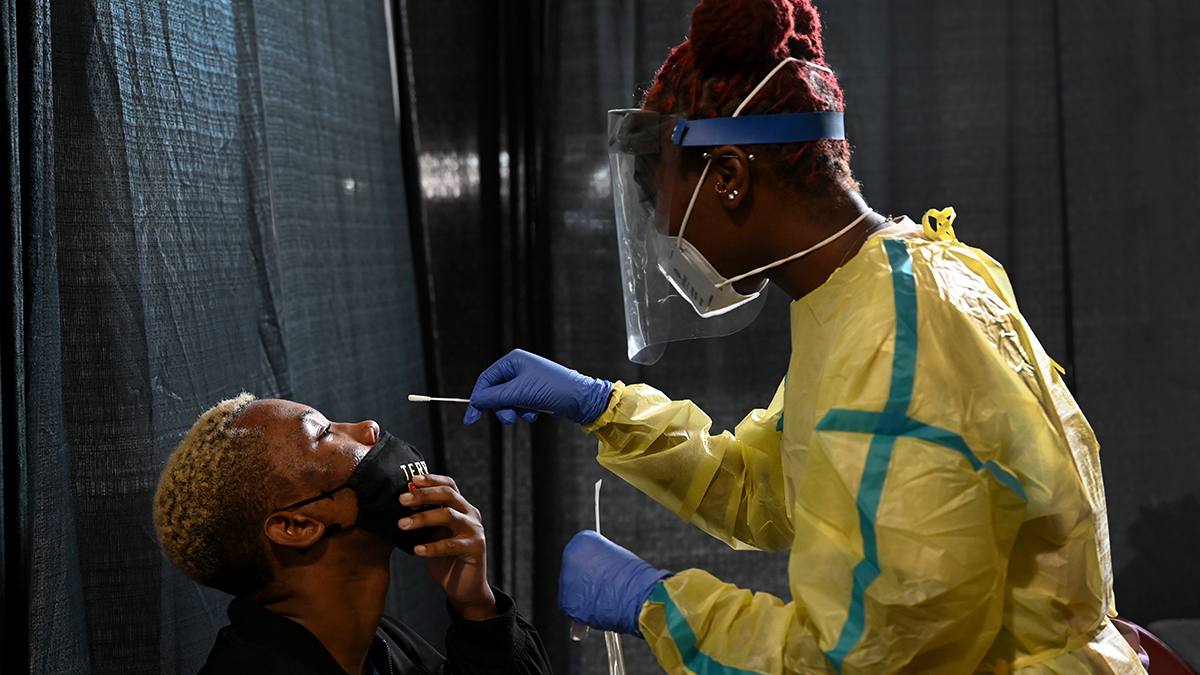Tuesday will be a major milestone in the fight against the coronavirus.
D.C., Maryland and Virginia on Tuesday each reported a higher number of new coronavirus cases than the day before.
Maryland surpassed 200,000 cases diagnosed throughout the pandemic.
Still, there are signs the recent surge is leveling out. Daily new cases are somewhat down from seven to 10 days ago.
However, it's unclear how the recent Thanksgiving holiday will impact the data. The nation is preparing for another surge in coronavirus cases that could potentially lead to more restrictions.
Gov. Larry Hogan announced at a press conference Tuesday that Maryland will begin preparing for a medical staffing surge as the pandemic worsens.
He called on colleges and universities to allow “early exit” for eligible healthcare students so they can help care for coronavirus patients. Maryland hospitals will also begin "making adjustments" by reducing noncritical procedures and transferring patients to other treatment facilities.
Hogan estimated that upwards of 2,000 to 3,000 people will be needed to step into roles at local hospitals over the next few weeks.
The governor also provided a few details on the expected number of vaccine doses Maryland is on track to receive from the federal government. The first batch will total around 155,000 doses – with about 50,000 from Pfizer and 105,000 from Moderna.
"The good news is they have great vaccines and they're years ahead of schedule." Hogan said. "The bad news is that it's not enough."
The vaccine doses will only be enough to cover half of Maryland's frontline workers, he said.
“The virus has taken the lives of over 268,000 Americans including 4,516 Marylanders," Governor Hogan said, striking a somber tone. "Sadly, we have lost our youngest victim, a one-year-old boy, to this deadly virus.”
The end of November marked the direst month of the pandemic: The U.S. added a record 4 million new cases in four weeks and 35,000 deaths.
After tens of millions of Americans traveled for the holiday, experts say the darkest days may be yet to come.
“As we go for the next couple of weeks into December, that we might see a surge superimposed upon that surge that we’re already in,” Dr. Anthony Fauci told “Meet the Press.”
Health experts say we could see new infections spike in the next five to 10 days.
Authorities say travelers should assume they have the virus and self-isolate.
D.C. health officials are sounding the alarm about the initial rollout of the vaccine in the District.
D.C. is set to only receive doses based on the number of people who live in the city, not the number of workers. But many of the District’s health care workers commute, officials say.
Since health care workers are a priority, counting only by population means receiving far fewer vaccines than are needed, D.C. Health Director LaQuandra Nesbitt said.
Nesbitt says D.C. has asked the federal government to reconsider that number, citing what she calls porous borders with Maryland and Virginia.
Right now, Moderna and Pfizer are moving millions of vaccine doses across the country.
They want the drugs ready to be distributed the moment the Food and Drug Administration gives the green light.
Both the Moderna and Pfizer COVID-19 vaccinations require two shots.
Health officials are worried about making sure they can get the shots to everyone who needs one.
The military will help rush vaccines to every state and territory, then it’s up to individual health departments to make sure they are properly distributed.
What the Data Shows
D.C. recorded an increase of 133 new COVID-19 infections and five additional lives lost. The seven-day average has held steady in the low 180s for the past two days.
In D.C. only 41.9% of those who test positive for COVID-19 are providing a list of close contacts to DC health officials. Those who do disclose contacts only list one person on average.
So far, a total of 202,647 D.C. residents have opted into the District’s contact tracing app.
Maryland officially surpassed 200,000 cases Tuesday. The state reported an additional 2,765 cases and an additional 30 lives lost. Tuesday’s case increase is the third-highest recorded increase throughout the span of the pandemic.
The spike in new cases caused Maryland’s seven-day rolling average to increase as well. Now at 2,239, the rolling average is still falling in line with an encouraging leveling trend. Average daily cases have been in the range of 2,200 to 2,300 for the past two weeks.
Hospitalizations in Maryland are still rising. A total of 1,583 Marylanders are currently hospitalized with COVID-19.
Virginia reported 1,662 new cases and 27 additional lives lost.
Similar to ongoing trends apparent in D.C. and Maryland, Virginia appears to show signs that new cases are leveling off.
The state’s rolling seven-day average is at 1,805, more than 100 cases less than what was reported last week. Although cases are flattening out, like the rest of the region, hospitalizations are up. Virginia reported its highest-ever number of hospitalizations (1,422) Tuesday.
Local Coronavirus Headlines
- Maryland Gov. Larry Hogan announced measures on Tuesday to boost the number of available health care workers and plan for more hospital beds.
- Thousands of Northern Virginia students returned to classrooms in Loudoun and Prine William counties Tuesday to begin hybrid learning.
- Some Fairfax County students have returned to all-virtual learning amid a rise in coronavirus cases.
- A total of 51,510 coronavirus tests were administered in Maryland last Friday, the highest ever on a single day.
- The Smithsonian is shutting down its museums and the National Zoo once again due to recent spikes in COVID-19 cases.
- A program that provided extended unemployment benefits to out-of-work Virginians ended earlier this month.
- COVID-19 numbers continue to paint a dire picture for Black Americans, and there is an ongoing effort in the Black community to increase testing.
- The Metro board voted to close a budget gap by changing how often trains run.
- Officials have reversed a decision to cancel the annual Wreaths Across America event at Arlington National Cemetery. The event, held in December, will happen after all.
- Maryland Gov. Larry Hogan announced how the state will allocate about $70 million in federal aid as the state braces for months of rising coronavirus cases.
- Maryland released a new contact tracing app, and has reduced indoor operations for bars and restaurants from 75% to 50% in response to rising coronavirus cases and increased hospitalizations.
- A review by the News4 I-Team has found concerns that Prince George’s County, which has the highest number of coronavirus cases in the state, has received what some are calling an underwhelming share of the more than $165 million in aid thus far.
- D.C. now requires travelers from all but four states get tested for COVID-19, once before travel and again if they plan to stay in the District for more than three days. Maryland, Virginia, Hawaii and Vermont are the exceptions.
Reopening Tracker
- Maryland tightened restrictions on businesses, bars and restaurants.
- All Smithsonian museums and the National Zoo closed because of rising COVID-19 cases, officials announced.
- Hours before some Fairfax County students were set to return to in-person learning, the school district said that they needed to delay the plan.
- Courts throughout Maryland partially shut down due to the pandemic.
- Virginia announced new measures to fight COVID-19 as cases of the virus have spiked across the country.
- Prince George's County tightened restrictions and required masks to be worn outdoors.
- Montgomery County reduced capacity limits at many businesses, including for indoor dining, to 25%. The county previously stopped giving waivers for alcohol sales after 10 p.m.
- D.C.'s mayor extended the city's coronavirus state of emergency to last through the end of the year.
How to Stay Safe
There are ways to lower your risk of catching coronavirus. Here are guidelines from the CDC:
- Wear a snug-fitting mask that covers your nose and mouth.
- Avoid being indoors with people who are not members of your household. The more people you are in contact with, the more likely you are to be exposed to COVID-19. If you are indoors with people you don’t live with, stay at least six feet apart and keep your mask on.
- Wash your hands often, especially after you have been in a public place.



